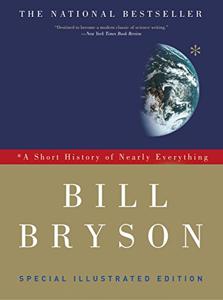
Want to learn the ideas in A Short History Of Nearly Everything better than ever? Read the world’s #1 book summary of A Short History Of Nearly Everything by Bill Bryson here.
Read a brief 1-Page Summary or watch video summaries curated by our expert team. Note: this book guide is not affiliated with or endorsed by the publisher or author, and we always encourage you to purchase and read the full book.
Video Summaries of A Short History Of Nearly Everything
We’ve scoured the Internet for the very best videos on A Short History Of Nearly Everything, from high-quality videos summaries to interviews or commentary by Bill Bryson.
1-Page Summary of A Short History Of Nearly Everything
Overall Summary
Bill Bryson begins his book by saying that he’s glad the reader can join him, since it wouldn’t have been possible without a long chain of history. The reader is alive today because of biological good fortune and luck. It has taken an extreme amount of time for species to evolve into what we are today, and 99% of all species go extinct before they ever get this far.
Bill Bryson also wonders why so many science books are written in a dull, technical way. He explains that he wrote this book because he wanted to see if it was possible to write about science in a way that would make readers marvel at the history of life on Earth and feel more curious about how scientific inquiry is done.
In Part 1, “Lost in the Cosmos”, Bryson talks about how our universe was formed. He explains that all matter is compressed into a tiny area and then expands rapidly to create space as we know it. Inflation theory (the idea that the universe is expanding) was first introduced in the 20th century. Bryson emphasizes how extraordinary it is that conditions were just right for life to exist on earth.
Bryson goes on to emphasize how huge the universe is and how far away Earth is from other celestial bodies. Pluto, for instance, is billions of miles away and remains elusive. There are hundreds of billions of galaxies in addition to the hundreds of billions of stars in our galaxy (the Milky Way). Also, when we look up at the sky we’re actually seeing light that’s been traveling for years since it takes so long for light from distant parts to reach us. Our solar system was formed over four billion years ago with a bunch of dust colliding until they gathered together into planets like Earth which has an atmosphere made up mostly carbon dioxide which traps heat from the sun and makes life possible here by warming Earth.
Newton discovers gravity and laws of motion in the 1700s. This triggers a series of expeditions to determine Earth’s size, shape, mass, and location in the solar system. Geology starts to pick up steam at this time as well with James Hutton who theorizes that mountains are formed by land masses crashing into each other. His theories were correct but nobody understood them because he wrote so obtusely. Nevertheless, interest in geology grew among affluent people who started digging up dinosaur bones even though it took scientists awhile to figure out what they were and recognize that species go extinct.
Bryson then looks at the work of Dmitri Mendeleyev, who created a chart to classify elements. Bryson also praises Marie Curie for her accomplishments and singular achievements.
In Part 3, “A New Age Dawns,” Bryson wryly notes that by 1900, scientists think they have figured out everything about the physical world. However, their understanding is about to be radically altered with Einstein’s theory of relativity and Planck’s quantum theory. On top of this, atomic scientists like Rutherford learn that atoms are mostly empty space and Bohr realizes electrons jump around in these spaces.
Bryson then talks about astronomy in the 1930s. At that time, women had limited opportunities to work outside their homes as they were mostly relegated to clerical roles. However, one of these women—Henrietta Swan Leavitt—discovered a way to measure distances between galaxies. Her discovery helped Edwin Hubble calculate that there are billions of galaxies beyond our own and it made him realize how vast the universe is. Bryson also discusses pollution problems with lead, CFCs and ozone depletion which has led to an increase in radiation from space leaking into Earth’s atmosphere.





